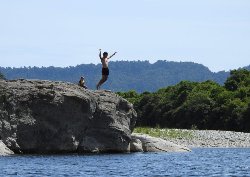Economic Research Charts Sharp Fall Then Slow Growth Until 2030
More information is emerging on the likely shape of the Wellington region’s post-COVID-19 economy.
New research from economic consultancy BERL paints a picture of the regional economy which, in the short term, shows falling GDP, rising unemployment and lower population growth, with substantial pick-up not expected for a decade.
Commissioned by Greater Wellington as a key input for its long term planning, the report Greater Wellington, COVID-19 Economic Impact, covers key regional impacts on population, gross domestic product, employment, unemployment, household income and consumer spending.
“The impact of COVID-19 means Greater Wellington has to reconsider the assumptions, forecasts and data it will use to prepare its long term and annual plans. Our plans have to be adjusted to the new economic realities we face.
“While the conclusions of the research challenge our existing thinking, it will help councils to plan their way through this volatile and difficult period with their eyes wide open,” says Greater Wellington Chair Cr Daran Ponter.
“It’s baseline information that needs to be shared throughout the region, among both local government and the private sector, to help make key decisions on which our economic recovery will be built.
“At several weeks remove from lockdown, it’s now clear that the sectors expected to be most affected are accommodation and food services, arts and recreation, personal services and administrative and support services.
“But it’s not all bad news. Sectors that have been able to transition to alternative ways of working such as public administration and safety, agriculture, fishing and forestry and information media and telecommunications will be the least impacted.
“Post-lockdown one of the key roles of Greater Wellington is to help drive economic growth in the region, or at the very least mitigate the impact of the recession.
“While the Wellington region is in the fortunate position of being cushioned by a government and professional workforce, the BERL report reveals the depth of the economic impacts ahead” says Cr Ponter.
“The key to minimising negative economic impacts will be developing a strong partnership with a government which is ready to invest in the region. Greater Wellington is focusing on securing investment in transport, climate change, flood protection and the environment, areas that will benefit the region’s infrastructure and deliver jobs.”
The findings of the research are based on three scenarios of economic performance under differing alert level constraints, and are therefore conservative.
According to the most optimistic scenario, Scenario 1, the region’s gross domestic product (GDP) is expected to reduce by 8.3 percent in the year to 31 March 2021.
Employment is expected to fall by 5.5 percent by March 2021 to 248,266 full time equivalent employees (FTEs), falling by a further 0.9 per cent in 2022 to 246,134. Employment will rebound in 2023, with the total number of FTEs increasing by 4.5 percent. Total employment in the region will reach 288,055 by 2030, an increase of 17 percent (41,922 FTEs) from the low expected in 2022.
Household income will fall with an associated decrease in consumer spending before both pick up as the economy slowly recovers from 2022 onwards.
GDP in the retail sector will decline by 16.3 percent in 2021 following COVID-19 restrictions on activity. It will recover by the same amount in 2022, growing to $2 billion by 2030, a 22.5 percent increase in retail trade over the decade.
The accommodation and food services industry will be hit the hardest by COVID-19. GDP in the accommodation and food services sector will fall by 63.9 percent in 2021. Although there will be some recovery, the industry contribution to regional GDP will remain below 2020 levels until past 2030.
The report Greater Wellington, COVID-19 Economic Impact is the second in a series of reports commissioned by Greater Wellington from BERL and follows Possible Impacts of COVID-19 on the Wellington Region and Greater Wellington, which was published in May.
To find the research:
http://www.gw.govt.nz/assets/Uploads/GWRC-COVID-19-Impacts-for-LTP-Final-for-GWRC.pdf
http://www.gw.govt.nz/assets/Uploads/GWRC-COVID-19-Impacts-for-LTP-Summary-FINAL.pdf


 Gordon Campbell: On When Racism Comes Disguised As Anti-racism
Gordon Campbell: On When Racism Comes Disguised As Anti-racism Brendon McMahon - Local Democracy Reporter: West Coast Swim Spot Testing Clear Of E-coli
Brendon McMahon - Local Democracy Reporter: West Coast Swim Spot Testing Clear Of E-coli Green Party: Government Throws Coal On The Climate Crisis Fire
Green Party: Government Throws Coal On The Climate Crisis Fire Labour Party: Public Transport Costs To Double As National Looks At Unaffordable Roading Project Instead
Labour Party: Public Transport Costs To Double As National Looks At Unaffordable Roading Project Instead The Treasury: New Paper On A Framework For Assessing The Economic And Fiscal Impacts Of Climate Change
The Treasury: New Paper On A Framework For Assessing The Economic And Fiscal Impacts Of Climate Change Government: Pet Bonds A Win/Win For Renters And Landlords
Government: Pet Bonds A Win/Win For Renters And Landlords Government: New Zealand Condemns Iranian Strikes
Government: New Zealand Condemns Iranian Strikes


